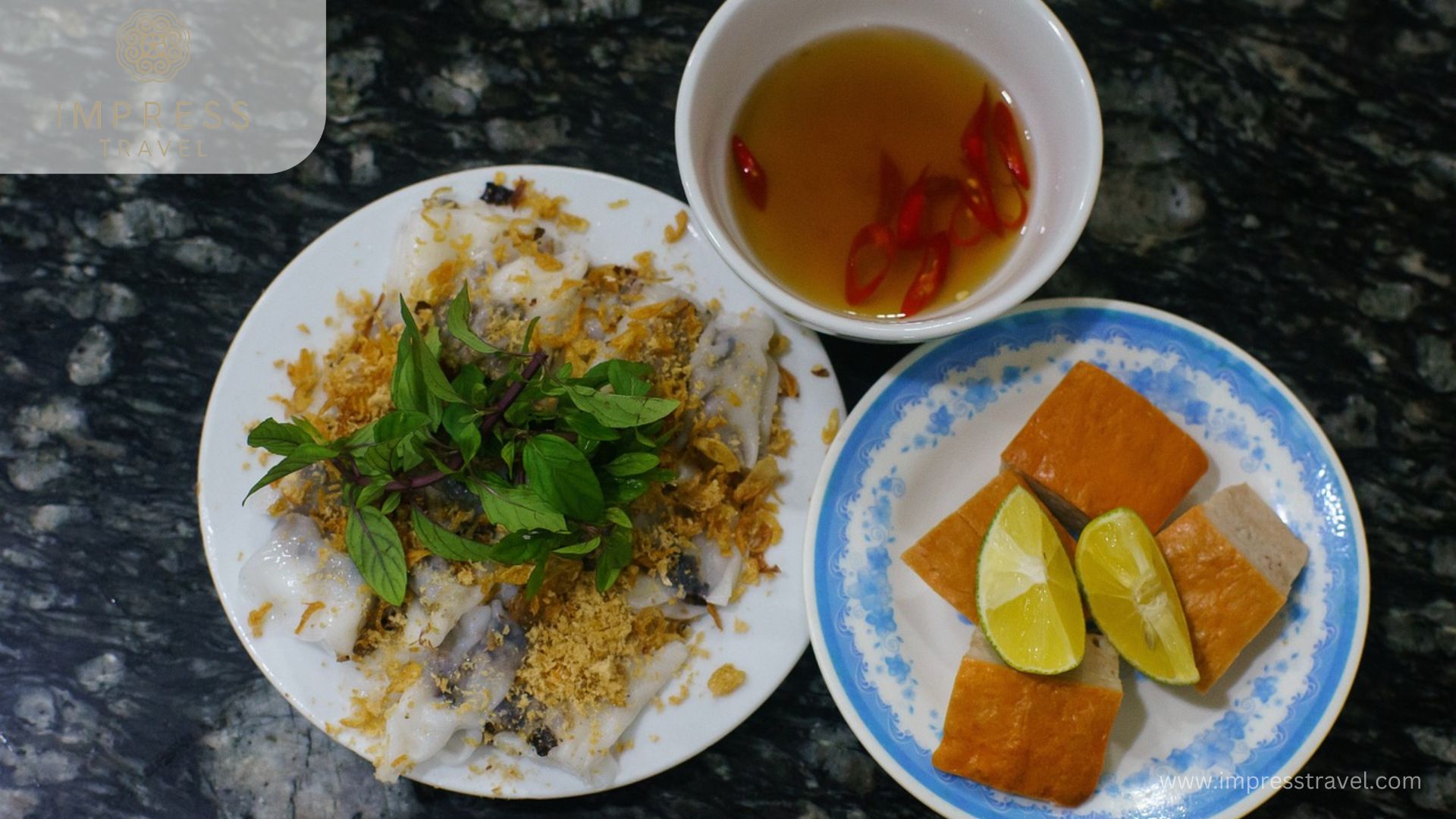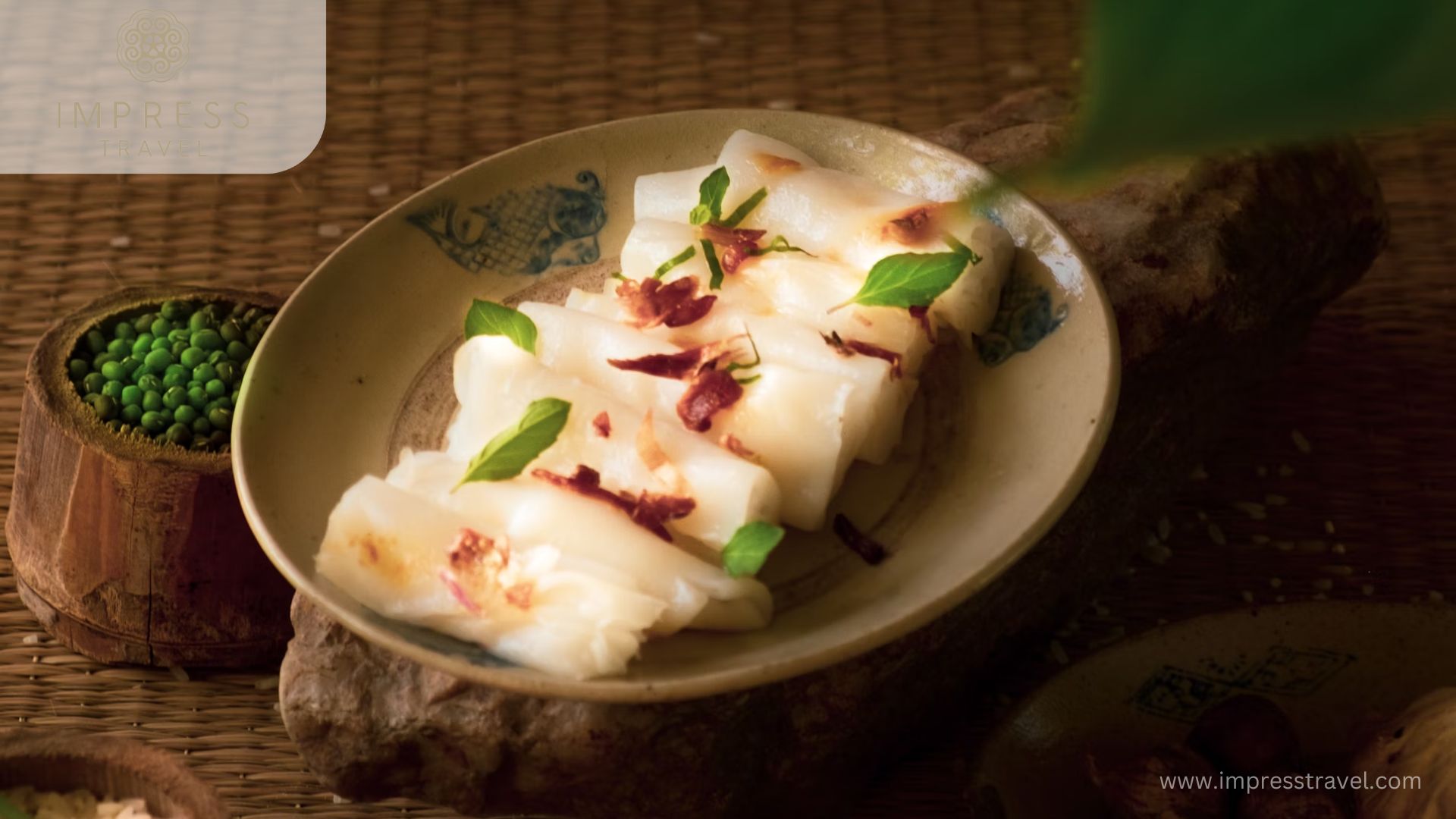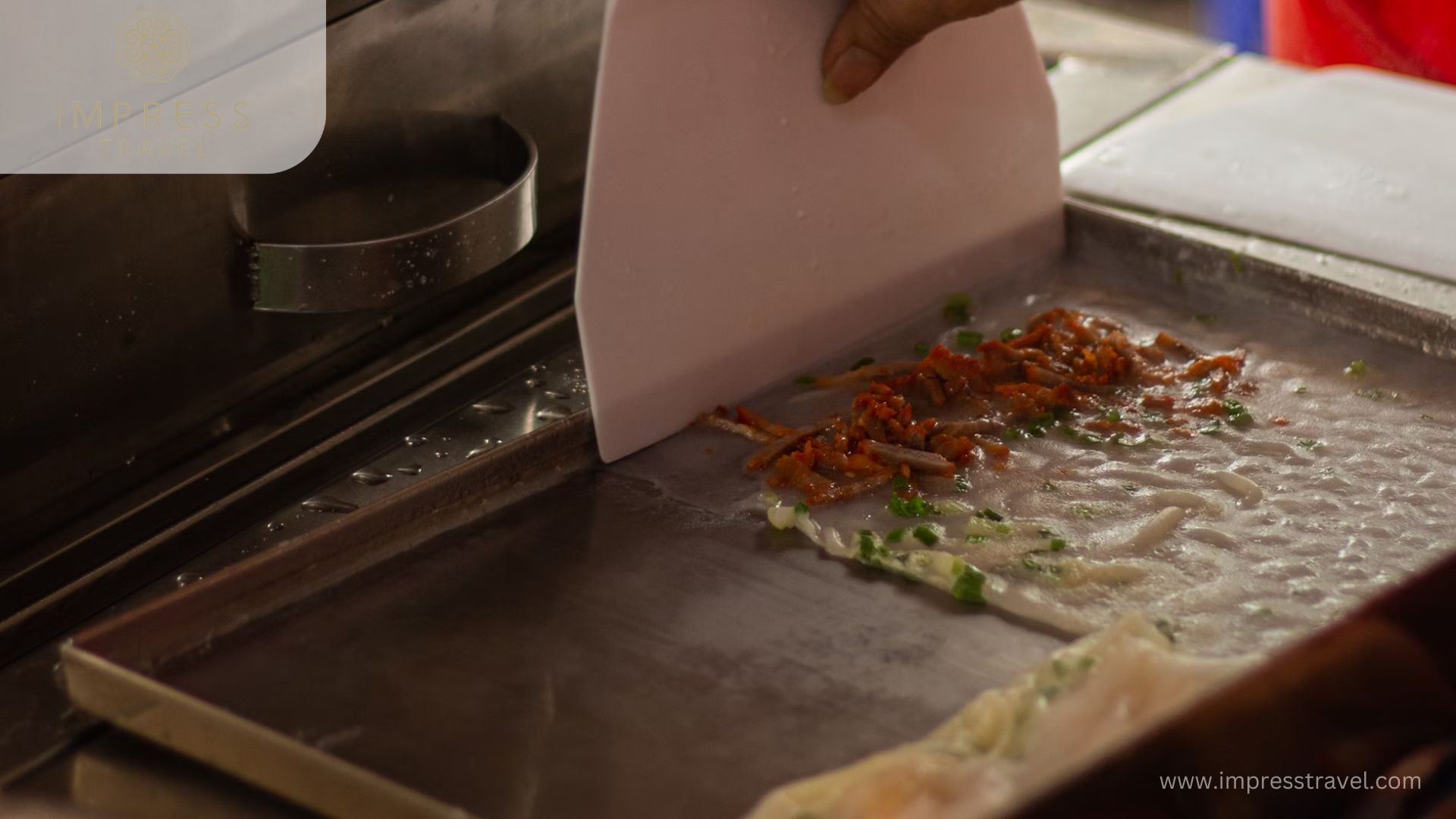Introduction

Banh cuon
The story of Banh Cuon is a tale steeped in tradition, ingenuity, and the rich culinary heritage of Vietnam. Dating back centuries, this beloved dish has captured the hearts and palates of generations, becoming a staple of Vietnamese cuisine and a symbol of the country’s vibrant culinary culture.
The origins of Banh Cuon can be traced back to Northern Vietnam, where it first emerged as a humble street food enjoyed by locals in the bustling markets and alleyways of Hanoi. Born out of necessity and creativity, Banh Cuon was created as a way to make use of simple and readily available ingredients to create a delicious and satisfying dish.
Legend has it that Banh Cuon was inspired by Chinese dumplings brought to Vietnam by traders and immigrants. Over time, Vietnamese cooks adapted and transformed these dumplings into the thin, delicate rice flour crepes that we know and love today. Drawing on the abundance of rice, pork, and aromatic herbs found in the region, they developed a recipe that would soon become a culinary sensation.
The name “Banh Cuon" itself translates to “rolled cake" in English, a nod to the process of making the dish. To create Banh Cuon, a thin layer of rice flour batter is poured onto a cloth stretched over a steaming pot, where it is steamed until soft and pliable. The resulting crepe is then filled with a savory mixture of ground pork, wood ear mushrooms, and shallots, before being rolled up and served with a tangy dipping sauce and fresh herbs.
Over the years, Banh Cuon has evolved and adapted to suit the tastes and preferences of different regions and generations. While the basic recipe remains largely unchanged, variations of the dish can be found across Vietnam, each with its own unique fillings, toppings, and accompaniments.
Today, Banh Cuon continues to hold a special place in the hearts of Vietnamese people, cherished for its delicate flavors, satisfying textures, and rich cultural heritage. Whether enjoyed as a quick snack on the streets of Hanoi or as a comforting meal shared with family and friends, Banh Cuon remains a beloved symbol of Vietnamese cuisine, inviting diners to savor the tastes and traditions of this vibrant and diverse country.
Story and History:

The taste of Banh Cuon
Banh Cuon traces its origins back to Northern Vietnam, where it has been a cherished part of the culinary landscape for centuries. While the exact origins of the dish are shrouded in the mists of time, Banh Cuon is believed to have been inspired by Chinese dumplings brought to Vietnam by traders and immigrants. Over the years, Vietnamese cooks adapted and transformed these dumplings into the thin, delicate rice flour crepes that we know and love today.
Course and Type:

Making banh cuon
Banh Cuon is typically served as a light and flavorful appetizer or snack, although it can also be enjoyed as a main course. The dish comes in several variations, with the most common being Banh Cuon Thanh Tri, which features a filling of ground pork, wood ear mushrooms, and shallots wrapped in a thin rice flour crepe. Other types of Banh Cuon may include different fillings such as shrimp, chicken, or tofu, as well as variations in the dipping sauce and garnishes.
The taste of Banh Cuon Ha Noi begins with the thin, silky rice flour crepe, which serves as the canvas for the dish. Made from a simple batter of rice flour and water, the crepe is cooked until soft and pliable, offering a light and airy texture that is both comforting and satisfying. Its subtle flavor acts as the perfect backdrop for the bold and aromatic fillings and toppings that accompany it.
One of the defining features of Banh Cuon Ha Noi is its filling, typically a mixture of ground pork, wood ear mushrooms, and shallots seasoned with fish sauce, sugar, and pepper. This savory filling adds depth and richness to the dish, with the earthy notes of the mushrooms complementing the umami flavors of the pork. Together, the filling and crepe create a harmonious marriage of flavors that is both comforting and familiar.
To enhance the taste of Banh Cuon Ha Noi, fresh herbs and garnishes are often added, including cilantro, mint, Vietnamese basil, crispy fried shallots, and sliced cucumber. These vibrant ingredients add freshness, texture, and a burst of flavor to each bite, elevating the dish to new heights of culinary delight.
Finally, no Banh Cuon Ha Noi experience would be complete without the tangy and savory dipping sauce that accompanies it. Made from fish sauce, sugar, lime juice, minced garlic, and chopped chili, the dipping sauce adds a zesty kick that cuts through the richness of the dish, balancing out its flavors and tantalizing the taste buds with its complex and aromatic profile.
Origin and Inventor:
While the exact origins of Banh Cuon are difficult to pinpoint, the dish is believed to have been invented in Northern Vietnam, where it quickly gained popularity among locals and travelers alike. Over the years, Banh Cuon has become a beloved staple of Vietnamese cuisine, with variations of the dish found in different regions across the country.
Serving and Ingredients:
The key ingredients in Banh Cuon include:
Rice flour batter: Made from rice flour, water, and sometimes tapioca starch, the batter is poured onto a cloth stretched over a steaming pot to create thin, delicate crepes.
Filling: Common fillings for Banh Cuon include ground pork, wood ear mushrooms, shallots, and sometimes minced shrimp or tofu.
Dipping sauce: Banh Cuon is typically served with a dipping sauce made from fish sauce, sugar, lime juice, garlic, and chili, which adds a tangy and savory flavor to the dish.
Garnishes: Banh Cuon is often garnished with a variety of fresh herbs such as cilantro, mint, and Vietnamese basil, as well as crispy fried shallots and sliced cucumber.
How to Cook:
To cook Banh Cuon at home, you will need the following ingredients:
Rice flour batter: Mix together 1 cup of rice flour, 2 cups of water, and 1 tablespoon of tapioca starch until smooth. Let the batter rest for 30 minutes.
Filling: Cook ground pork, wood ear mushrooms, and shallots in a pan until fully cooked. Season with fish sauce, sugar, and pepper to taste.
Dipping sauce: Mix together fish sauce, sugar, lime juice, minced garlic, and chopped chili to taste.
Garnishes: Prepare fresh herbs, crispy fried shallots, and sliced cucumber for garnishing.
Instructions:
Heat a non-stick skillet or crepe pan over medium heat. Pour a ladleful of rice flour batter onto the skillet and spread it evenly to create a thin crepe. Cover the skillet and cook for 1-2 minutes until the crepe is set.
Spoon a small amount of the filling onto the center of the crepe and fold it over to form a roll. Repeat with the remaining batter and filling.
Serve the Banh Cuon warm with the dipping sauce and garnishes on the side.
How to Serve:
Banh Cuon is traditionally served fresh and hot, with each roll of crepe filled with savory goodness and dipped in the tangy sauce before being enjoyed. The dish is often accompanied by a variety of fresh herbs and garnishes, which add freshness and texture to each bite. To serve Banh Cuon, arrange the rolls on a plate and garnish with the prepared herbs, crispy fried shallots, and sliced cucumber. Serve the dipping sauce on the side for guests to enjoy at their leisure.
Where to Eat:
While Banh Cuon can be found at many restaurants and street food stalls throughout Vietnam, some of the best places to sample this delectable dish include:
Banh Cuon Gia An:
Located in Hanoi’s Old Quarter, Banh Cuon Gia An is renowned for its fresh and flavorful Banh Cuon served with a variety of fillings and garnishes.
This restaurant has so many branches, some famous addresses are:
21A Lo Duc – Hai Ba Trung
61 Huynh Thuc Khang – Dong Da
70 Trung Hoa – Cau Giay…
Banh Cuon Ba Hanh:
Another popular destination for Banh Cuon in Hanoi, Banh Cuon Ba Hanh offers a wide selection of fillings and dipping sauces to suit every taste. You can go to these addresses: 66 To Hien Thành – Hai Ba Trung or 6/50 Dang Thai Mai – Tay Ho
Banh Cuon Phuong:
Banh Cuon Phuong is also a reliable address for you to enjoy Hanoi’s specialty banh cuon. The most outstanding feature of this restaurant is that every dish is hot. Hot rolls, hot dipping sauce, hot rolls, ensuring absolute deliciousness.
The roll crust here is quite thick, which may not be to the taste of many diners. However, the plump, rich filling is a plus point. The restaurant’s menu is quite diverse with traditional meat rolls or rolls, eggs…
Address: 68 Hang Cot – Hoan Kiem
Conclusion
In conclusion, banh cuon is a delightful Vietnamese dish that captures the essence of the country’s culinary heritage. With its delicate rice wrappers, flavorful filling, and fresh accompaniments, it offers a unique taste experience.Whether enjoyed as a quick snack on the go or as a leisurely meal with family and friends, Banh Cuon is a dish that captures the essence of Vietnamese cuisine with its delicate flavors and textures. So, the next time you find yourself in Vietnam, be sure to seek out this culinary delight and experience the magic of Banh Cuon for yourself.
Don’t forget to regularly follow our Facebook page and Website for more interesting information about traveling to Hanoi and to book Hanoi tours at the best prices.











































































